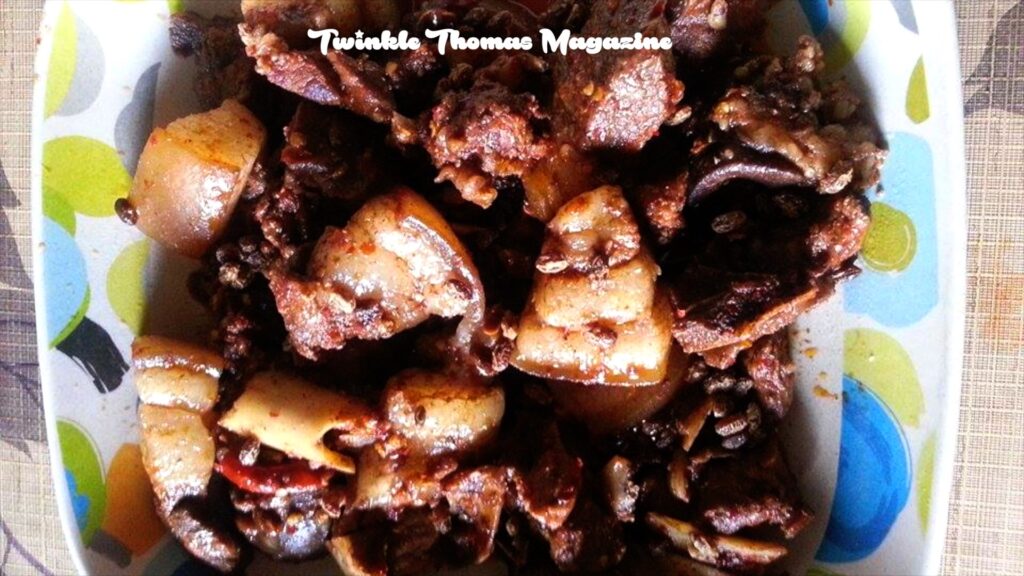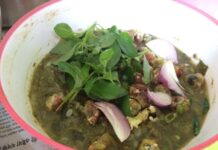Pork Akhuni-fermented delight from Nagaland
Nestled in misty hills is the city of kohima, capital of Nagaland. As I drove up from dimapur to kohima, the nip in the air started to get to me, but more importantly the verdant hills with mist swirling round her tops were mesmerizing. After a hard day’s work I was invited to a friend’s place for a late dinner by naga standards at about 6 pm. Not wanting to be rude but stomach doing flips having heard a lot of stories about naga food involving dogs I went into eat. For sure when the food was served the first thing that assaulted me was the overwhelming smell of the dishes and I felt that my worst fears were about to come true. All the same with a bit of cajoling from my friends I mustered up the courage to taste the ware set aside for me rice, boiled vegetables (cucumber and cabbage leafs today), fish bas tenga and pork akhuni. Bas tenga is fermented bamboo shoot while the akhuni is fermented soya bean. As I controlled my nose and popped in the first few morsels of the bas tenga and akhuni, my taste buds started popping in my mouth to the riot of flavours it were experience the acrid sour of fermentation to the spicy hot of the bhut jolukas, the spiciest chillis in the world. It’s been a spicy love story between me and the nagas since then.
In today’s food journey I will be taking a trip with one of my first tasted naga dishes pork with akhuni. Before we go into the dish let me take a minute to tell you about akhuni. Akhuni or as some call it axone is one of the principal fermented product used in naga cooking. Every tribe among the 16 major tribes of Nagaland and sub tribes has its own variation of making akhuni, and mothers make this year round and drying this send to children spread across New York to New Zealand dried in banana leaf parcels. To make akhuni, soya bean is first washed thoroughly and then boiled well making them soft. The water is then drained and the soya bean is now left in the sun in a pot to ferment. Fermentation takes about 3 to 4 days in the sunny weather of the summer and longer in winter. The typical smell of the akhuni indicates that the fermentation is done, at which point it is transferred to a wooden mortar and mashed with a wooden pestle. This is now placed in banana leafs made into parcels and dried. These are what are sent out, but then this is the outline and there are umpteen variations.
Naga pork curry is a traditional dish and again every tribe has its own variation of this dish, and so what I attempt here is maybe a mix of all and a bit main land adaptation of this delectable offering. The pork can be changed with chicken or beef. My apologies at the outset to my friends who might miss some of the traditional elements, but happy cooking anyways.
The ingredients we need are as below:
Smoked pork 1 kg
Akhuni 200gms
Bhut Joluka (naga chilli) 10 (red chillis are a poor substitute if bhut joluka is unavailable)
Ginger 10 gms
Salt to taste
Mejenga seeds 20

To prepare for cooking first wash the pork thoroughly, and cube it into big pieces and set aside. Chop the ginger and pound it and set aside. Roast a protion of the mejenga seeds on a dry pan and then grind it into a fine powder and set aside. Also fry a bit of mejenga seeds and set aside for garnishing.
Heat water in a big pot, to which add the pork, akhuni, the bhut joluka along with salt to taste. Cover the pot and let this cook for a few minutes. Now remove the chillis that have been added and have softened a bit and crush them in a mortar and pestle as the pork continues to cook in the covered pot. Set this aside for later use. Kepe cooking the pork in the pot till the meat gets tender, at which point add the crushed jolukas, along with the ginger paste made and mejenga powder made. Let this now cook over a slow fire for some time with the pot uncovered. One of the tricks in making this dish work is letting it simmer over a low fire letting it imbibe the basic tastes of the akhuni, chilli and ginger in the meat. After about 20 to 30 minutes of slow cooking taking care that the water is adequate the curry is ready, transfer to a serving bowl and garnish with the fried mejenga seeds. Serve this with steaming rice and quell your nose and dig in to transport to the pristine hills of Nagaland.
Like all my other dishes my mother’s secret ingredient of love and smiles will surely work for this dish also. To know the reason just walk into a naga kitchen where a mother is making the akhuni to send out and see the love she puts into it, and then peep in a kitchen far away where the akhuni is being used and see the smiles. So love smile and enjoy. Bon appétit.






